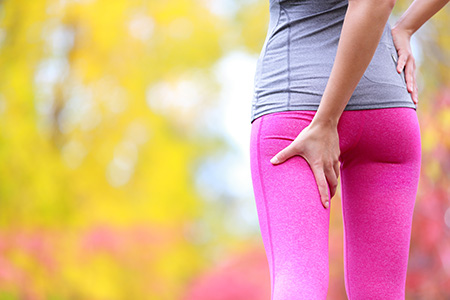By Karrie Osborn, Editor, Body Sense magazine
This article was originally published in the Autumn 2015 issue of Body Sense magazine.

You may not realize this, but your gluteal muscles—those that make up your derrière—are tangential to everything else in your body and affect nearly every movement you make.
Many massage clients only seek out gluteal massage work when they have a specific issue—a tight hamstring, for example. But you might want to think more broadly if you want to maintain your overall physical health. The truth is, dysfunctional gluteal muscles can be tied to low-back pain, shoulder issues, even foot and ankle pain.
Why the Glutes?
Receiving massage work on your gluteal muscles is critical for several reasons. Consider your glutes as the force that connects your upper and lower body. As such, it impacts everything above and below it. “Working on the gluteals should not be confined to just clinical therapeutic work,” says bodywork teacher and Certified Advanced Rolfer Art Riggs. “It should also be included in any full-body massage as a way to integrate the important connection—energetically and structurally—between the client’s lower and upper body.”
What Does Glute Work Look Like?
The way massage therapists approach your glutes is no different than how they address any other part of your body, with the exception of some additional draping considerations. And, as with any other part of your body, your therapist may work your gluteal muscles with his or her forearms, knuckles, or elbows, and utilize techniques like pin-and-stretch, kneading, acupressure, cross-fiber friction, and traditional Swedish massage strokes. Therapists addressing these muscles are looking to not only strengthen the gluteals, but to relax and align them, too.
Draped or Undraped?
There are two ways to address the gluteal muscles in your massage session. Some massage therapists prefer to work the glutes through a sheet, allowing them to use a more aggressive therapeutic approach on the muscle group. Other therapists prefer working on exposed skin, using a secure gluteal drape, to really meet the tissue head-on. And some therapists incorporate both ways of addressing these strong, dense muscles.
As with any massage or bodywork session, the client maintains control of his or her own body. If you want to leave your underwear on during a massage session, you are more than welcome to do so. Therapists will still be able to address your gluteal muscles, although clothing can inhibit the quality of the therapist’s work. Regardless, your therapist will be able to adjust his or her technique to accommodate your modesty needs.
Speak Up
Finally, while your gluteal muscles should not be ignored, you might find that in some sessions you’re not comfortable with work in that area. At any time you can ask your therapist to stop what she’s working on and move elsewhere. This applies to any part of your massage and at any point during your session. You can also discuss your goals with the therapist before the session begins. Remember, you’re in charge during your massage session, so don’t hesitate to speak up if the pressure is too deep or not deep enough, if the room is too warm or too cold, or if you’d rather he not work your glutes (or your feet, or your face, or …) that particular day.
Our gluteal muscles are more important than we might think, and although they spend a lot of their time being sat on, their role in the human body is integral and complex. In your next massage session, make sure they get the attention they deserve!
What Are the Glutes?
The gluteal group is comprised of three muscles: the gluteus maximus, gluteus medius, and gluteus minimus. These muscles stabilize the pelvis and spine and create powerful movement at the hip joint. As a group, they affect our posture and gait, and are crucial to most movements we make throughout the day.
• The gluteus maximus is the largest, and one of the strongest, muscles in the body. It creates the shape of the posterior and is responsible for movement of the hip and thigh.
• Under the maximus is the gluteus medius, a fan-shaped muscle that works to stabilize your walking gait, among many other functions.
• Finally, the gluteus minimus sits underneath the medius, and is the smallest and deepest of the group. It works in tandem with the gluteus medius to create critical movements.




